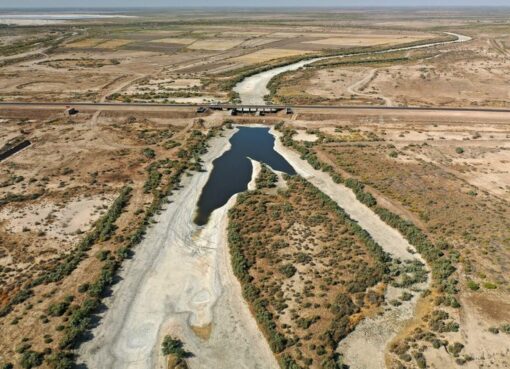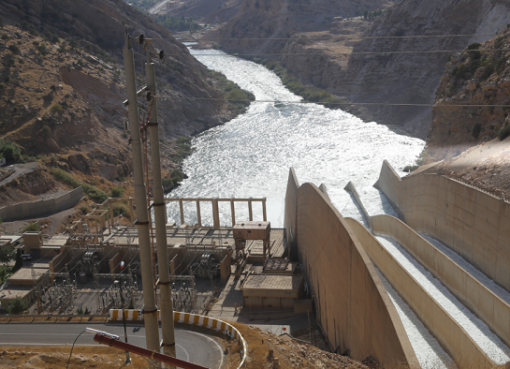The River Tigris faces a number of real dangers, most of them associated with completed projects or ones underway in neighboring states. The most important are:
- The Ilisu Dam in Turkey (under construction).
- The diversion of river tributaries originating in Iran (either underway or perhaps in most cases completed).
- The huge pumping station in Syria that aims to pump out a part of the river’s discharge.
- Global warming and the resulting droughts and water shortages (still in their early stages, but there are already obvious and tangible signs of them).
The four dangers listed above deserve detailed studies, which cannot be entirely addressed in this article aiming to educate public opinion and draw the attention of those concerned to the need to take practical steps to address these risks. Therefore, I will focus on the first factor only, without getting involved in technical and detailed information.
Some Of The Characteristics Of The River Tigris
The Tigris is the largest of Iraq’s rivers, with an average discharge doubling that of the River Euphrates, and even exceeding it over the past two decades following the completion of a number of Turkish and Syrian dams on the Euphrates.
The River Tigris, in contrast to the Euphrates, is characterized by the fact that it has a number of tributaries inside Iraq, such as the Upper Zab, Lower Zab, al-‘Adhaim River and the Diyala Rivers. With the exception of Haditha Dam on the River Euphrates, all Iraqi dams are located on the Tigris or its tributaries, such as: Mosul; Dukan; Darbandikhan; Hamrin; and al-‘Adhaim dams. These are the biggest Iraqi dams, and are used to store water for irrigation purposes or to generate hydroelectric energy.
The main sources of the River Tigris are to be found in Turkey and account for around 42% of its total flow volume. The major sources of its tributaries are in Iran (accounting for about 20% of its flow) and Iraq (about 38% of its annual total flow). So the River Tigris is in a better condition than that of the Euphrates, since all Euphrates sources and tributaries are to be found outside Iraq – except in the flood seasons when runoff takes place from the western highlands into the Euphrates; but this does not contribute to more than 3% of its flow even under the best possible conditions.
The river enters at the Iraqi-Turkish-Syrian border triangle, after running for 40km along the Syrian-Turkish border. Its annual average flow at the Iraqi border is about 22billion cubic meters (BCM), representing the inflows to the Mosul Dam, situated 50km north of the city of Mosul and considered to be Iraq’s biggest. This has a storage capacity of 11BCM, representing more than half the river’s flow, which is used for irrigation and hydroelectric power generation.
The Vital Interdependence Of The Two Rivers
The Tigris River in Iraq is reasonably flexible in the way its flow is managed because of the existence of a number of major dams and facilities along its course and on its tributaries. In addition to the fact that around 20BCM of its annual average flow is sourced from inside Iraq. This means that it is less affected by measures taken by neighboring countries than the River Euphrates is.
The area cultivated by the Tigris River in Iraq covers about 8million donums, double that cultivated in the Euphrates River basin. And in general the soil in the Tigris River basin is more fertile than that in the Euphrates basin due to morphological and climatic factors. It also needs less water due to limited rice cultivation, for which the lands close to the Euphrates River are famous taking into consideration that rice needs a lot of irrigation water compared with other crops.
It should be noted that since the end of the 1970s, it has been possible to divert some of the water from the Tigris to the Euphrates in years of scarcity and when there has been an increased demand for irrigation water in the Euphrates basin. This happens by using of the Tharthar lake, through the huge Tigris-Tharthar Canal controlled by Samaraa Barrage. Water is then taken from Lake Tharthar via another canal to the River Euphrates called Tharthar-Euphrates Canal. It is also possible to boost the capacity of the River Tigris at times of need from the Lake Tharthar via a third canal called Tharthar-Tigris Canal.
This vital interdependence of the two rivers, in addition to a chain of other hydraulic structures, represent the backbone for the management of Iraq’s water resources, making it – to a large extent – a robust system, subject to continuous improvements according to changing circumstances.
The Tigris and Euphrates also meet in other places in Iraq, most notably south of Kut and Nassiriya cities. The mixed waters here constitute a hydrological phenomenon that is unique in the region and is of huge significance in economic, social, environmental and cultural terms known as the Mesopotamian Marshes. For the Tigris provides more than 50% of the waters of the Hawizah Marshes to the southeast of ‘Amarah, via the Musharrah and Kahlaa rivers, and more than 50% of the Qurnah Marshes to the southwest of ‘Amarah in the area bordered by the two rivers, via the Butira, ‘Aryidh, al-Majar al-Kabir rivers and others, and where the course of the Euphrates passes through the al-Qurnah Marshes to the north and the Hammar Marshes to the south.
But the most famous place where the two rivers meet is at the historic city of Qurnah, where Shatt al-‘Arab is created by them and proceeds southwards for more than 110km before flowing into the Gulf.
Painful Reality
It is worth mentioning that the drinking water consumed by the inhabitants of Nassiriya on the Euphrates comes from the River Tigris, rather than from the Euphrates River. The same goes for other towns like Suq al-Shuyukh, where there is a scheme to distribute the water that supplies al-Nassiriya in the al-Bad’a district on the Gharraf River that branches off the Tigris.
Similarly with Basra, where the waters of the Gharraf River (that is to say Tigris water) are pumped along an open canal which is 240km long from the Bad’a district. It is known now as the ‘Basra Water Canal’, but used to be called the ‘Canal of Loyalty to the Leader’ and has been bringing drinking water to the citizens of Basra since the mid-1990s.
Mentioning these two cases of drinking water being brought to Nassiriya and Basra from the Tigris might seem amusing to some people. But actually it is a cause for grief and an indicator of the magnitude of the catastrophe that has befallen Iraq – and especially the south.
The waters of the river Euphrates in Nassiriya are not fit for human consumption, even after treatment, because of the high saline content, and for this reason the town has had to depend on the River Tigris 50km away to meet its drinking water needs.
As for Basra, which used to be floating on lakes of fresh water, both in Shatt al-‘Arab and in the six well-known canals (Saraji, Khoura, ‘Ashar, Khandaq, Rabat and Jubaila) it has become “captivated” by the ‘Canal of Loyalty to the Leader’ since the 1990s. From the time of the Iran-Iraq war and throughout the subsequent wars the fresh water of Basra has become contaminated and salinated and the six canals have become places to dump garbage, thus forcing Basra to be totally dependent on an open canal exposed to sabotage, neglect and contamination.
Basra was the first victim of the wars and neglect, and is in dire need of immediate action, exceptional effort and huge sums of money, in addition to speedy work with Iran, which now controls the freshwater resources in Basra in the form of the Karun and Karkheh Rivers. These used to provide more than 90% of the fresh water in the Shatt al-Arab before their courses were diverted.
Turkey’s Ilisu Dam
This is a vast dam under construction on the River Tigris and is the second biggest in the irrigation project for Southeast Anatolia which is known as GAP after the Ataturk Dam on the Euphrates. The Ilisu Dam is situated 65km from the Iraqi-Turkish-Syrian borders and has the capacity to hold 11BCM of water, i.e. half the annual flow of the Tigris River from its sources in Turkey. The plan is for the dam to generate hydroelectric energy and control the disbursement of water for irrigation over a vast area, consisting of 120,000 hectares north of the Iraqi border.
Turkey has been trying to establish this dam since the middle of the last century, but for a number of reasons was prevented from doing so. Some of these reasons were financial, while other related to security and political issues, for the dam is situated in an area where the Kurdish Workers’ Party (PKK) was militarily active. The scheme was also a part of the GAP project that is on-going for a long time according to a preset schedule and plan. After the security challenges eased in the region, financial ones emerged, resulting from the need to invest more than $2bn to build the dam. So the Turkish government turned to the international market and secured agreement with three European governments to provide financial guarantees for the large companies seeking to finance the project. They were the governments of Germany, Austria and Switzerland.
Public pressure exercised by Turkish and European civil society groups succeeded in July 2009 in changing the positions of the three European governments and stopping the funding of the project on the grounds that it violated international norms. They also pointed to the failure of the Turkish government to give credible safeguards to assure the European creditors or guarantors that the construction of the dam and its future mode of operation were in line with international standards adopted by the World Bank, or those applied by EU countries, especially those relating to the environmental and social aspects of the project.
When completed the dam will submerge the historic town of Hasankeyf, in addition to a number of villages, and will have a devastating environmental and economic effect on Iraq – and especially on the Iraqi marshes that are of international importance. But Europe’s refusal to finance the scheme has not prevented Turkey from continuing to implement the project which is now being funded by Turkish banks, one of which is headquartered in Bahrain.
Will Ilisu Kill Off Mosul Dam?
Turkey’s Ilisu Dam will have a devastating effect on Iraq for a number of reasons, the most important of which is the possibility that it will put Mosul Dam out of action, if not on a permanent basis, then at least for many years. For the Mosul Dam will not be used for the same purposes for which it was built once the Ilisu Dam has been completed. It will be half as efficient as before, except when there are floods and Ilisu Dam is full.
Mosul Dam was designed to retain the natural flow of water, with the capacity to store 11BCM of it for use in Iraq for irrigation and power generation. The completion of Ilisu – being the same size as the Mosul Dam – will mean a decline in the flow of the River Tigris to Iraq by about a half, according to estimates from the Iraqi Ministry of Water Resources. Obviously the operation of the Ilisu Dam after completion will be to meet Turkish needs mainly, and Mosul Dam will no longer be able to receive the natural flow of the river which is known for its spring flooding. Rather, it will be subject – virtually – to the operation of the Ilisu Dam and the volume of water released from the facility and the use of the water for irrigation. Furthermore, Turkey is to build Cizre Dam, a second irrigation dam on the Tigris, south of Ilisu and close to the Iraqi border. Its capacity will be a quarter of Ilisu’s, but will be dedicated entirely to providing water for irrigation.
The proposed operating plan for the Ilisu Dam indicates that Turkey will allow a minimal flow of 60 cu ms/second to meet environmental needs (including, of course, Iraq’s needs). This is a very small flow and will meet only a fraction of Iraq’s environmental requirements (the Iraqi marshes, for example), aside from economic needs – for agriculture and power generation in particular. On a point of information, the annual average natural flow rate for the Tigris River is more than 650 cu ms/second.
The Worst Case Scenario
One of the most dangerous phases that the River Tigris will have to pass through is that when the Ilisu Dam is filled once it has been completed. On the assumption that the completion of the building work is during a period when the Tigris is being affected by drought similar to what we have been experiencing now (2007-2011), i.e. three to four years of scarcity, then filling the dam will happen only when the water situation improves. The effect will be to intensify the scarcity in Iraq, stretching the drought to six or eight years, and consequently devastation the agricultural sector in Iraq.
There are well-known technical problems in the foundations of the Mosul Dam and work to deal with them by building a large, thick cut off wall under the body of the dam is continuing. The plan to establish the wall may require emptying the water from the dam, in part or totally. If that is what happens and it is followed by the filling of the Ilisu Dam and followed in turn by a natural drought, then Iraq’s economy and environment will face grave dangers. The period of water scarcity and drought could extend for more than 10 years. This is a situation that those involved in the management of water resources cannot ignore, because hydrology is a science based on probable occurrences of events and here one cannot be certain of the changes to come.
The general view of the Tigris River as a whole indicates a clear deterioration in the quantity and quality of its waters. The tributaries running from Iran to the Diyala River, for example, (and it is an important tributary of the Tigris) and in the southern sector of the river and the Shatt al-‘Arab are cut off completely. If one adds to this Turkish control of the river by means of the Ilisu Dam and the withdrawal of huge volumes from the river, with Syria pumping out 1.5BCM a year, then the indomitable Tigris River faces the prospect of being transformed into a tiny stream incapable of supporting life that has existed in its basin for thousands of years.
(*) Former Iraq’s Representative to the FAO in Rom, currently Director General in the Iraqi Ministry for Foreign Affairs








Comment here